Loading AI tools
Geometric operation which truncates the edges of polyhedra From Wikipedia, the free encyclopedia
In geometry, chamfering or edge-truncation is a topological operator that modifies one polyhedron into another. It is similar to expansion: it moves the faces apart (outward), and adds a new face between each two adjacent faces; but contrary to expansion, it maintains the original vertices. (Equivalently: it separates the faces by reducing them, and adds a new face between each two adjacent faces; but it only moves the vertices inward.) For a polyhedron, this operation adds a new hexagonal face in place of each original edge.
In Conway polyhedron notation, chamfering is represented by the letter "c". A polyhedron with e edges will have a chamfered form containing 2e new vertices, 3e new edges, and e new hexagonal faces.
In the chapters below, the chamfers of the five Platonic solids are described in detail. Each is shown in an equilateral version where all edges have the same length, and in a canonical version where all edges touch the same midsphere. (They look noticeably different only for solids containing triangles.) The shown dual polyhedra are dual to the canonical versions.
| Chamfered tetrahedron | |
|---|---|
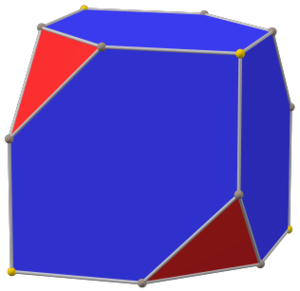 (equilateral form) | |
| Conway notation | cT |
| Goldberg polyhedron | GPIII(2,0) = {3+,3}2,0 |
| Faces | 4 congruent equilateral triangles 6 congruent equilateral* hexagons |
| Edges | 24 (2 types: triangle-hexagon, hexagon-hexagon) |
| Vertices | 16 (2 types) |
| Vertex configuration | (12) 3.6.6 (4) 6.6.6 |
| Symmetry group | Tetrahedral (Td) |
| Dual polyhedron | Alternate-triakis tetratetrahedron |
| Properties | convex, equilateral* |
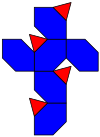 Net | |
| *for a certain chamfering/truncating depth | |
The chamfered tetrahedron or alternate truncated cube is a convex polyhedron constructed:
For a certain depth of chamfering/truncation, all (final) edges of the cT have the same length; then, the hexagons are equilateral, but not regular.
The dual of the chamfered tetrahedron is the alternate-triakis tetratetrahedron.
The cT is the Goldberg polyhedron GPIII(2,0) or {3+,3}2,0, containing triangular and hexagonal faces.


 chamfered tetrahedron (canonical form) |
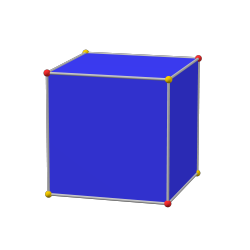 dual of the tetratetrahedron |
 chamfered tetrahedron (canonical form) |
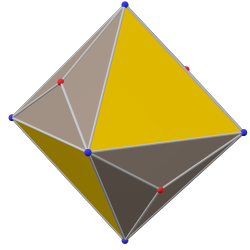 alternate-triakis tetratetrahedron |
 tetratetrahedron |
 alternate-triakis tetratetrahedron |
| Chamfered cube | |
|---|---|
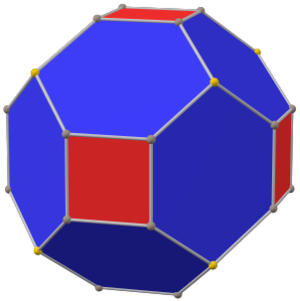 (equilateral form) | |
| Conway notation | cC = t4daC |
| Goldberg polyhedron | GPIV(2,0) = {4+,3}2,0 |
| Faces | 6 congruent squares 12 congruent equilateral* hexagons |
| Edges | 48 (2 types: square-hexagon, hexagon-hexagon) |
| Vertices | 32 (2 types) |
| Vertex configuration | (24) 4.6.6 (8) 6.6.6 |
| Symmetry | Oh, [4,3], (*432) Th, [4,3+], (3*2) |
| Dual polyhedron | Tetrakis cuboctahedron |
| Properties | convex, equilateral* |
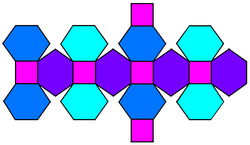 Net (3 zones are shown by 3 colors for their hexagons — each square is in 2 zones —.) | |
| *for a certain chamfering depth | |
The chamfered cube is constructed as a chamfer of a cube: the squares are reduced in size and new faces, hexagons, are added in place of all the original edges. The cC is a convex polyhedron with 32 vertices, 48 edges, and 18 faces: 6 congruent (and regular) squares, and 12 congruent flattened hexagons.
For a certain depth of chamfering, all (final) edges of the chamfered cube have the same length; then, the hexagons are equilateral, but not regular. They are congruent alternately truncated rhombi, have 2 internal angles of and 4 internal angles of while a regular hexagon would have all internal angles.
The cC is also inaccurately called a truncated rhombic dodecahedron, although that name rather suggests a rhombicuboctahedron. The cC can more accurately be called a tetratruncated rhombic dodecahedron, because only the (6) order-4 vertices of the rhombic dodecahedron are truncated.
The dual of the chamfered cube is the tetrakis cuboctahedron.
Because all the faces of the cC have an even number of sides and are centrally symmetric, it is a zonohedron:

The chamfered cube is also the Goldberg polyhedron GPIV(2,0) or {4+,3}2,0, containing square and hexagonal faces.
The cC is the Minkowski sum of a rhombic dodecahedron and a cube of edge length 1 when the eight order-3 vertices of the rhombic dodecahedron are at and its six order-4 vertices are at the permutations of
A topological equivalent to the chamfered cube, but with pyritohedral symmetry and rectangular faces, can be constructed by chamfering the axial edges of a pyritohedron. This occurs in pyrite crystals.
|
Pyritohedron and its axis truncation |
Historical crystallographic models of axis shallower and deeper truncations of pyritohedron |

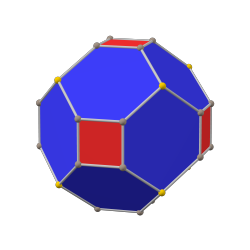 chamfered cube (canonical form) |
 rhombic dodecahedron |
 chamfered octahedron (canonical form) |
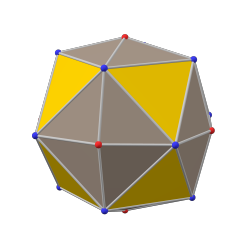 tetrakis cuboctahedron |
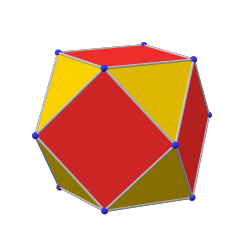 cuboctahedron |
 triakis cuboctahedron |
| Chamfered octahedron | |
|---|---|
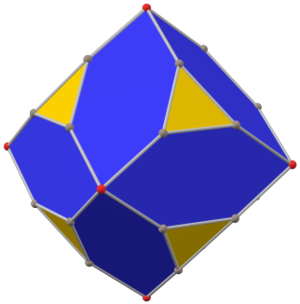 (equilateral form) | |
| Conway notation | cO = t3daO |
| Faces | 8 congruent equilateral triangles 12 congruent equilateral* hexagons |
| Edges | 48 (2 types: triangle-hexagon, hexagon-hexagon) |
| Vertices | 30 (2 types) |
| Vertex configuration | (24) 3.6.6 (6) 6.6.6.6 |
| Symmetry | Oh, [4,3], (*432) |
| Dual polyhedron | Triakis cuboctahedron |
| Properties | convex, equilateral* |
| *for a certain truncating depth | |
In geometry, the chamfered octahedron is a convex polyhedron constructed by truncating the 8 order-3 vertices of the rhombic dodecahedron. These truncated vertices become congruent equilateral triangles, and the original 12 rhombic faces become congruent flattened hexagons.
For a certain depth of truncation, all (final) edges of the cO have the same length; then, the hexagons are equilateral, but not regular.
The chamfered octahedron can also be called a tritruncated rhombic dodecahedron.
The dual of the cO is the triakis cuboctahedron.

| Chamfered dodecahedron | |
|---|---|
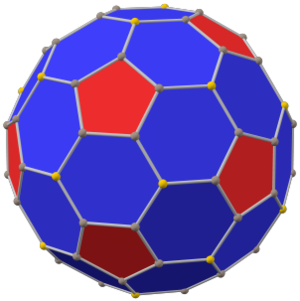 (equilateral form) | |
| Conway notation | cD = t5daD = dk5aD |
| Goldberg polyhedron | GPV(2,0) = {5+,3}2,0 |
| Fullerene | C80[2] |
| Faces | 12 congruent regular pentagons 30 congruent equilateral* hexagons |
| Edges | 120 (2 types: pentagon-hexagon, hexagon-hexagon) |
| Vertices | 80 (2 types) |
| Vertex configuration | (60) 5.6.6 (20) 6.6.6 |
| Symmetry group | Icosahedral (Ih) |
| Dual polyhedron | Pentakis icosidodecahedron |
| Properties | convex, equilateral* |
| *for a certain chamfering depth | |
The chamfered dodecahedron is a convex polyhedron with 80 vertices, 120 edges, and 42 faces: 12 congruent regular pentagons and 30 congruent flattened hexagons.
It is constructed as a chamfer of a regular dodecahedron. The pentagons are reduced in size and new faces, flattened hexagons, are added in place of all the original edges. For a certain depth of chamfering, all (final) edges of the cD have the same length; then, the hexagons are equilateral, but not regular.
The cD is also inaccurately called a truncated rhombic triacontahedron, although that name rather suggests a rhombicosidodecahedron. The cD can more accurately be called a pentatruncated rhombic triacontahedron, because only the (12) order-5 vertices of the rhombic triacontahedron are truncated.
The dual of the chamfered dodecahedron is the pentakis icosidodecahedron.
The cD is the Goldberg polyhedron GPV(2,0) or {5+,3}2,0, containing pentagonal and hexagonal faces.

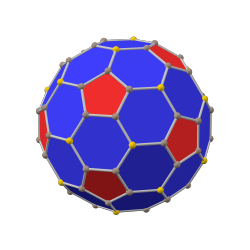 chamfered dodecahedron (canonical form) |
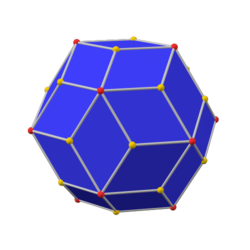 rhombic triacontahedron |
 chamfered icosahedron (canonical form) |
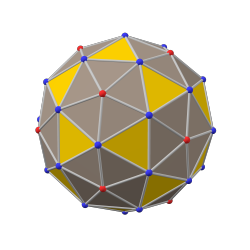 pentakis icosidodecahedron |
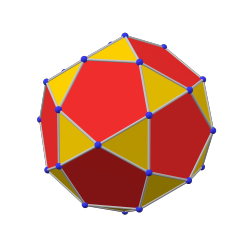 icosidodecahedron |
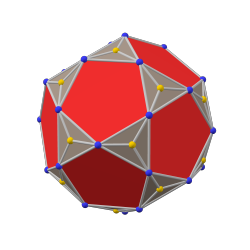 triakis icosidodecahedron |
| Chamfered icosahedron | |
|---|---|
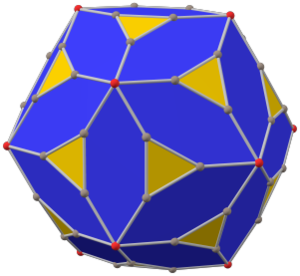 (equilateral form) | |
| Conway notation | cI = t3daI |
| Faces | 20 congruent equilateral triangles 30 congruent equilateral* hexagons |
| Edges | 120 (2 types: triangle-hexagon, hexagon-hexagon) |
| Vertices | 72 (2 types) |
| Vertex configuration | (24) 3.6.6 (12) 6.6.6.6.6 |
| Symmetry | Ih, [5,3], (*532) |
| Dual polyhedron | Triakis icosidodecahedron |
| Properties | convex, equilateral* |
| *for a certain truncating depth | |
In geometry, the chamfered icosahedron is a convex polyhedron constructed by truncating the 20 order-3 vertices of the rhombic triacontahedron. The hexagonal faces of the cI can be made equilateral, but not regular, with a certain depth of truncation.
The chamfered icosahedron can also be called a tritruncated rhombic triacontahedron.
The dual of the cI is the triakis icosidodecahedron.
 Square tiling, Q {4,4} |
 Triangular tiling, Δ {3,6} |
 Hexagonal tiling, H {6,3} |
 Rhombille, daH dr{6,3} |
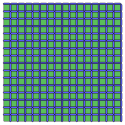 |
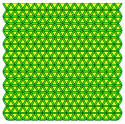 |
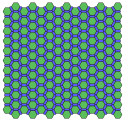 |
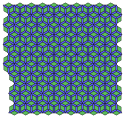 |
| cQ | cΔ | cH | cdaH |
The chamfer operation applied in series creates progressively larger polyhedra with new faces, hexagonal, replacing the edges of the current one. The chamfer operator transforms GP(m,n) to GP(2m,2n).
A regular polyhedron, GP(1,0), creates a Goldberg polyhedra sequence: GP(1,0), GP(2,0), GP(4,0), GP(8,0), GP(16,0)...
The truncated octahedron or truncated icosahedron, GP(1,1), creates a Goldberg sequence: GP(1,1), GP(2,2), GP(4,4), GP(8,8)...
A truncated tetrakis hexahedron or pentakis dodecahedron, GP(3,0), creates a Goldberg sequence: GP(3,0), GP(6,0), GP(12,0)...
Like the expansion operation, chamfer can be applied to any dimension.
For polygons, it triples the number of vertices. Example:
For polychora, new cells are created around the original edges. The cells are prisms, containing two copies of the original face, with pyramids augmented onto the prism sides.[something may be wrong in this passage]
Seamless Wikipedia browsing. On steroids.
Every time you click a link to Wikipedia, Wiktionary or Wikiquote in your browser's search results, it will show the modern Wikiwand interface.
Wikiwand extension is a five stars, simple, with minimum permission required to keep your browsing private, safe and transparent.